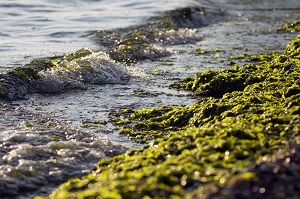
Nutrient Pollution and the Cost to the Environment
By Carter McAuley, Vice President
Runoff and erosion are common problems in construction, farming, and other industries, often caused by storms and other extreme weather. Your insured may think erosion and runoff issues are just a natural consequence of normal business operations or an act of nature. However, they may not realize the devastating effects they can have to the environment and their business’ bottom line.
According to the EPA, algae blooms are caused by nutrient pollution―the polluted runoff from any number of human activities which contain high levels of nitrogen and phosphorus that allow the natural algae blooms to grow out of control. This runoff can be caused by any number of industries and products.
This past year, Florida reported several deaths of manatees in lagoons and waterways statewide. The cause was a toxic algae bloom that killed off the sea grasses that the manatees eat. This toxic algae bloom covered the state’s largest body of fresh water, Lake Okeechobee, and several other connected waterways. The blue-green “sludge” prompted the governor of Florida to declare a state of emergency.
Florida was just the most recent report of a toxic algae bloom. In September 2015, over 600 miles of the Ohio River was covered in an algae bloom. In August 2015, Lake Erie experienced an algae bloom that affected tap water for hundreds of thousands of people. China, California, British Columbia and the Chesapeake Bay have all seen large, toxic blooms that have killed off marine plant life, shellfish, birds, marine mammals and fish.
What is an algal bloom?
An algal (algae) bloom is a colony of cyanobacteria that grows rapidly due to nitrogen and phosphorus deposits. This large colony uses up the dissolved oxygen in the water, which can kill off the fish and plant life. Without the fish and plant life, large marine species like the manatee will often starve.
What causes an algal bloom?
Many industries have the potential to contribute to or cause a toxic algal bloom. Landscaping companies spraying or spreading manure, contractors clearing or working land without proper erosion control, farm operations and improper treatment of wastewater or sewer overflow are often cited as leading contributors in nutrient pollution. Even household cleaning products containing phosphorus can contribute to an algal bloom if the products are introduced into a watershed (these products can include bathroom cleaners, descalers, soaps, car wax and wash, sealants and rust removers).
What are the risks?
In addition to the damage that large algal blooms can cause to wildlife populations, algal blooms can also affect domestic pets and humans. Exposure to contaminated water can lead to nausea, vomiting, and even acute liver failure in humans. The cost to tourism and industry should not be overlooked either. Algal blooms negatively impact tourism to popular fishing destinations or beaches. The EPA estimates the annual lost revenue for harmful algal blooms to be over twenty million dollars.
How can a company protect themselves?
Environmental insurance products that can help address this risk. A Contractors Pollution Liability policy can help address cleanup, property damage, and even help mitigate the cost of damages to natural resources (such as restocking fish, etc.). Premises Pollution Liability policies can address first and third party cleanup of the contamination as well as bodily injury and property damage caused by the release of contaminated wastewater or chemical spills. These products address the basic concerns relating to this exposure, and there are additional coverages and enhancements that should also be considered.
Understanding nutrient pollution and algal blooms is an important concern for many classes of business. Not only do businesses need to take precautions and have responsible business practices in order to be successful, they need to consider to broader impact to the environmental and wildlife. Contact Beacon Hill Associates for more information on pollution exposures and environmental products.
Information in this article was obtained from the following sources:
http://www.nytimes.com/2016/07/19/science/algae-blooms-beaches.html?_r=0
Type: Blog